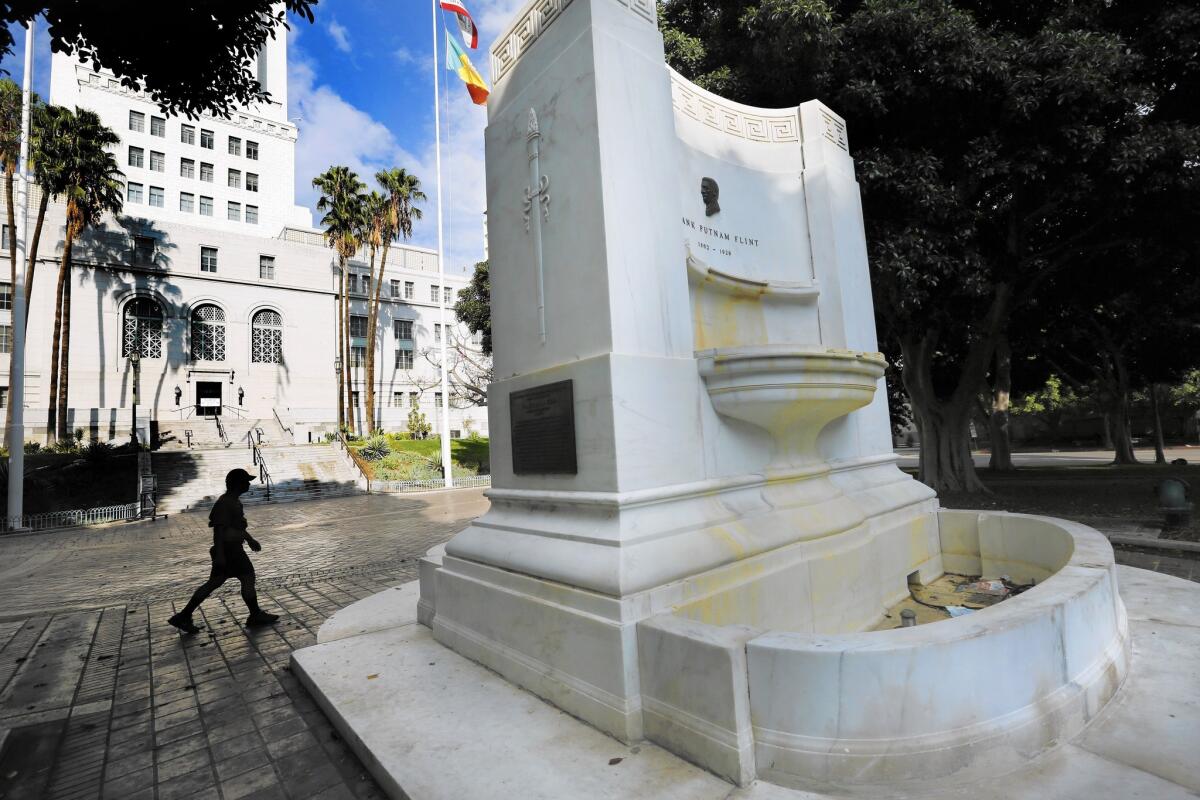To save water, which L.A. fountains should be turned off?

- Share via
Even if unconsciously, the homeless people who loll on the south lawn of Los Angeles City Hall are making a sacrifice to conserve water during the drought.
The small gurgling Frank Putnam Flint fountain that for decades has serenaded midday sleepers has been silenced.
It’s one of about a dozen fountains and pools in and around City Hall that the city has drained to prevent the loss of precious water by evaporation.
But the loss is not borne equally around downtown.
A short walk up the hill from City Hall at the west end of Grand Park, where government workers and tourists mix near a Starbucks, the soothing patter of splashing water can still be heard.
Children pad across the membrane pool — a sheet of water spread over a stone surface — and jets of water rise ostentatiously from a large hemispherical pool and gigantic stone bowl in the shadow of the county Hall of Administration.
Water and Power is The Times’ guide to the drought. Sign up to get the free newsletter >>
Nearby, the spacious moat surrounding the L.A. Department of Water and Power’s headquarters, the largest body of water in downtown, remains full.
The divergent fates of the civic waterworks reflect the tension between the symbolic and the practical in the battle against drought.
The closure of the city’s fountains was mostly symbolic.
In the scalloped marble bowl of the Flint fountain, the city’s Department of General Services has placed a porcelain sign announcing “This fountain is shut off in accordance with Mayor Garcetti’s Executive Order No. 5 Creating a Water Wise City.”
Garcetti issued the order last October as the “bold plan” the city required to respond to the drought. It called for a 20% reduction in water use by residents and city agencies over two and a half years. But it did not explicitly order fountains turned off.
Lisa Gabriel, chief sustainability officer for the department that operates city buildings, said the decision to dry up the fountains was meant “to support the city’s conservation efforts” but not based on any analysis of the actual amount of water lost to evaporation.
At the Flint fountain, the savings wouldn’t be much.
Evaporation is influenced by many variables: air and water temperature, depth, wind speed and agitation. But surface area is the main factor. Based on a rule-of-thumb formula devised by evaporation expert Nate Adams of the Santa Margarita Water District in Orange County, a basin of that size would lose about five gallons — or about two toilet flushes — each day. The actual loss would probably be less because of the plentiful shade from the south lawn foliage.
Across 1st Street, at the bone-dry reflecting pool at LAPD headquarters, the payoff is greater. At roughly 3 feet by 100, its 300-square-foot surface would lose about 26 gallons every day. That may or may not seem worthwhile to a steady stream of 1st Street pedestrians.
Up the hill, the operators of the two largest water displays say draining them would be impractical.
The Music Center, which runs the Grand Park fountain and pool, has reduced the water jets that make the fountain an eye-catching highlight of any stroll through the park. That cut the loss because water evaporates much faster from a spray than a flat surface.
Officials considered a total shutdown of the water features but rejected the idea because of concerns the plumbing would corrode, said Bonnie Goodman, the Music Center’s spokeswoman.
Goodman said no analysis was done to determine how much water would have been saved. But the pool covers about 19,000 square feet, meaning evaporation would claim at least 1,500 gallons a day, according to Adams’ formula.
The DWP, whose 1.2-million-gallon reflecting pool could swallow all the other downtown fountains, is also constrained by technology, said spokeswoman Michelle Figueroa.
In addition to being an architectural feature, the pool is tied into the building’s cooling system, Figueroa said. About 2.5 million gallons of wastewater from the cooling towers goes into it each year.
That water, which would otherwise go down the drain, offsets about half the daily evaporation, Figueroa said.
The agency has given a nod to the drought by reducing to three hours a day the running time of the jets that once animated the expanse of water surrounding its Hope Street headquarters.
That still leaves about 10,000 gallons of fresh water — about half a residential swimming pool — lost every hot summer day.
Twitter: @LATDoug
ALSO
Sand replenishment at Malibu’s Broad Beach is a dune deal
Fair offers students of color a better shot at prep school dreams
Mayor’s return to church where protesters disrupted him is scuttled
More to Read
Sign up for Essential California
The most important California stories and recommendations in your inbox every morning.
You may occasionally receive promotional content from the Los Angeles Times.











